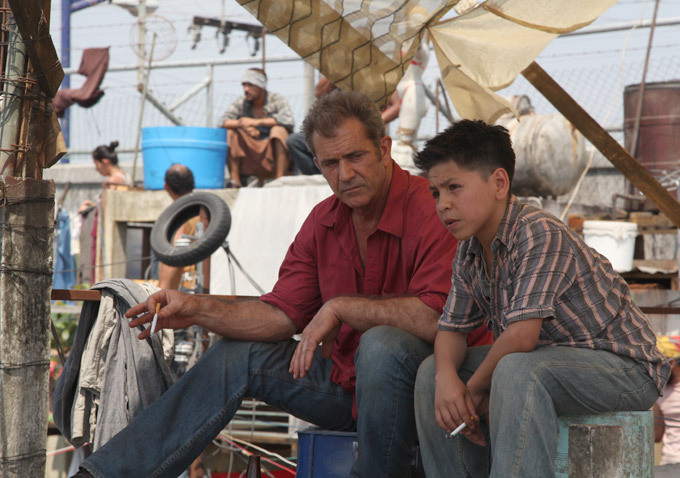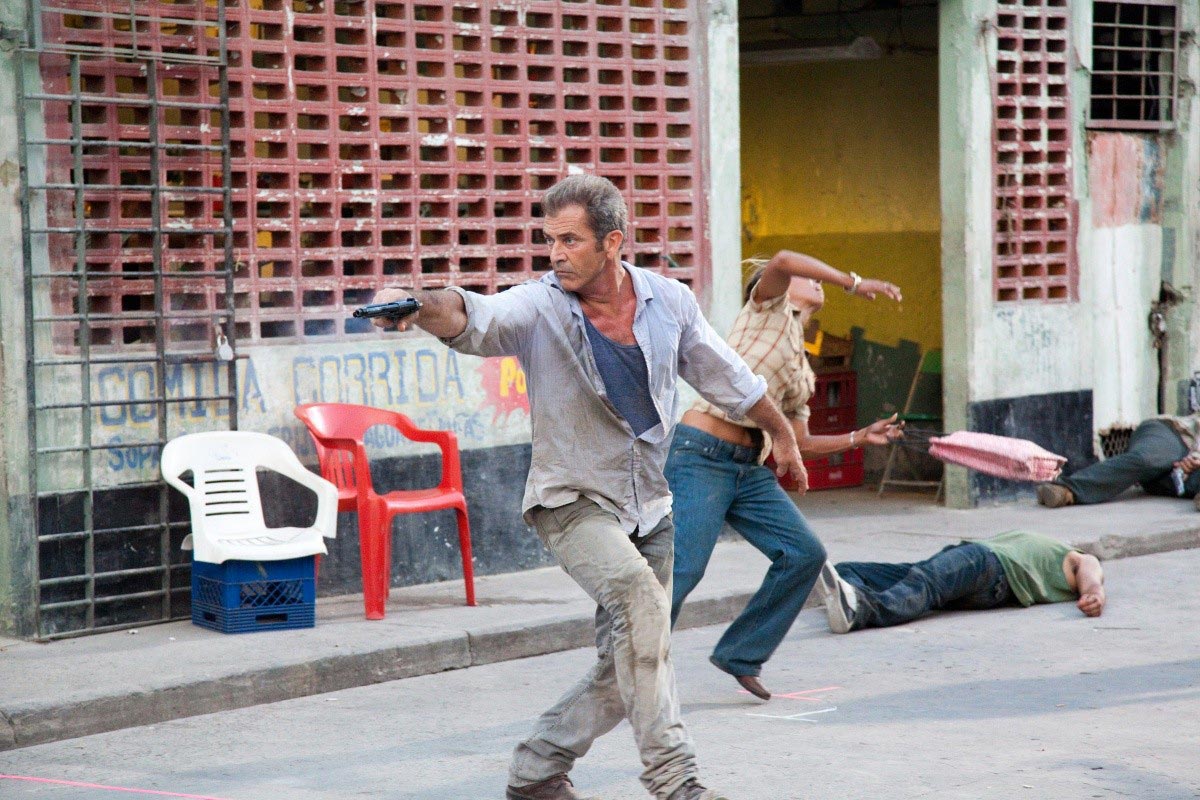|
Get the Gringo
Reviewed
by
Damien Straker on
May 17th, 2012
Icon presents
a film directed by Adrian Grunberg
Screenplay
by
Adrian Grunberg, Mel Gibson and Stacy Perskie
Starring:
Mel Gibson, Kevin Hernandez and Dolores Heredia
Running
Time: 95 mins
Rating:
MA
Released: May 31st,
2012
|
2/10
|
|
A man known only as Driver (Mel Gibson) is fleeing in a
getaway car from the US Border Patrol. In the back of his car is a haul
of
several million dollars and his accomplice who is bleeding to death.
When Driver
crashes in Mexico he is arrested and thrown into the prison 'El
Pueblito'. The
place has the look of a filthy, rough prison but it is also populated
with
children, shops and drug dens. The place is overrun by organized crime,
meaning
that the wealthy and the cunning stand at the top of its hierarchy and
the
guards are bought. Driver has a military background as a sniper and
uses his
vision to assess the area. He befriends a ten year old boy (Kevin
Hernandez) who
is being targeted by a crime boss because he is the right match for a
liver
transplant. Driver looks to protect the boy and his mother (Dolores
Heredia)
but there are people who are still keen to take back the money that he
stole.

Get the Gringo is from first time director Adrian Grunberg, who was an
assistant on Mel Gibson's Apocalypto (2006).
Gibson helped him co-write the screenplay and was also a producer
himself,
which suggests that he must have thought this film was a good idea. The
only
redeeming feature of this appallingly savage and unpleasant film is its
setting. The way that it is visualised here, as a free roaming compound
overruled by gangsters, I could hardly believe that such a place would
exist.
Driver's voice over, narrating the film, asks us: "Was this a prison or
the world's shittiest mall?" Yet according to reports, 'El Pueblito'
was
actually real. Prisoners could shop freely and the drug trade was so
viable
that it became pertinent in upholding the facilities economy. The
prison was
shut down back in 2002, after it was raided by two thousand law
enforcement
officers. I think it would make for a fascinating documentary to
explore how
such an institution could be so morally and politically bankrupt. The
setting
is undeniably intriguing but it's wasted on a subpar crime story that
is
increasingly implausible, stupid, cliché ("He killed my father!") and
derivative of better films, including Gibson's own Payback
(1999). The direction of the film is as careless as the
spatiality that is depicting. The look of the film feels right. It's
grubby,
sweaty and ugly: the textures belong to a hardcore prison block. Yet
the
potential for a realistic and detailed prison drama is undone by
immature
writing and meaningless stylistic decisions. Gibson and Grunberg are
interested
in selling an attitude but with little reasoning. They try their
hardest to
shock. Take an early freeze-frame on Driver's friend as he coughs up
blood in
the backseat of the car. The image is paused momentarily so that we can
see the
blood spurting out of his mouth. What's the point?

Similarly, Gibson now in his mid-fifties, is intent on
pushing himself as an action hero with a chip on his shoulder. It's
like he's
joined forces with Liam Neeson, determined to prove that geriatrics
have still
got it. He willingly throws himself into embarrassing slow-motion
gunfights and
commando rolls but gives us no reason to care whatsoever. Most of the
personality in his dry, one-note performance is derived solely from his
voice-over, which offers a handful of quips to lighten the mood. The
one
question I have about Driver is concerned with his athleticism. When he
was in
the army, how regularly did they practice the move of diving in midair
to catch
a grenade to throw it back? Did he learn this from fielding in cricket
matches?
The film would like to be Robert
Rodriguez's Desperado (1995) but it's
missing the fun. Some of the gunfights are cartoon-like, which is at
odds with
the violence that is offensively harsh. The boy and his mother are
abused in
the most heinous ways, forcing us to endure moments of torture that
only the
disturbed or easily amused could enjoy. I found it utterly repulsive.
Violence
can be brutal, as it is in any Tarantino film, but it must always have
a
purpose. Relying on shock value, like Gibson and his director do here,
is the
cheapest and laziest way of drawing a reaction from people.
Interestingly, it
must have been decided that the film would not bode well with American
audiences as it is not seeing a theatrical release there. Wisely, it's
going
straight to video-on-demand services. I've already called the film a
rehash of Payback but it seems as though Gibson's
career is retracting in so many other ways.
|